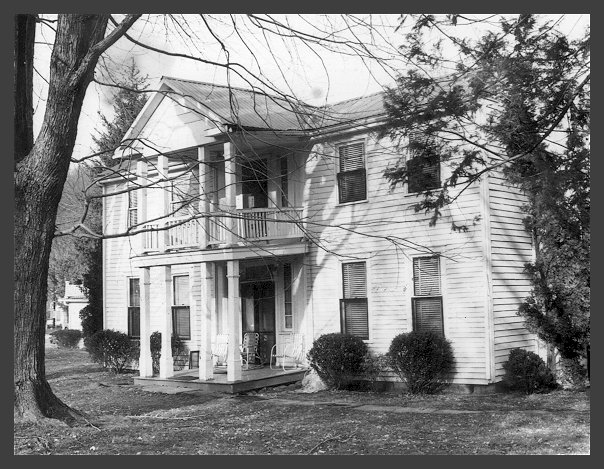 |
| Built in 1857 by Prestonsburg attorney John M. Burns, the house later known as "The Garfield Place" was located on the east bank of the Big Sandy opposite the mouth of Middle Creek, on ground occupied today by the First Commonwealth Bank. Following his victory, Colonel Garfield used the house as his temporary headquarters. Facing the Levisa Fork of the Big Sandy River, the Burns House stood in the middle of several acres of cleared bottom land, and a boat landing was located at the lower end of its long front yard. Burns was the law partner of John M. Elliott, one of the region's best-known secessionists. Though he was a Union man himself, Burns fled to Louisa when Garfield's troops occupied Prestonsburg, fearful that his association with Elliott would cause him to be arrested for treason. Because of its excellent location at the mouth of Middle Creek, Garfield comandeered the house upon his arrival in Prestonsburg and used it as his temporary headquarters during the ten days that followed the Battle of Middle Creek. Garfield's soldiers set up their tents on the land surrounding the house, which later became known as the Garfield Addition. Most Prestonsburg families sided with the South, and when Garfield arrived in the town, he discovered that most of its houses and barns were vacant and stripped of provisions. A native of Boyd County, Burns served in the State Legislature during the 1850s and later served as Circuit Judge of the Sixteenth Judicial District. His law partner, John M. Elliott, was an outspoken advocate of states rights who served three terms in the U. S. Congress during the 1850s. When the war came, Elliott served as a recruiting officer for the 5th Kentucky Infantry, C.S.A. and then resigned in order to serve in the Confederate Congress. When Burns fled to Louisa, he left behind his wife Keziah and his son Rowland. Mrs. Burns was too sick to accompany him, so Rowland stayed behind in order to nurse her and guard her from the Union troops. On the evening following their victory at Middle Creek, before Garfield arrived on the scene, Union soldiers broke into the house and stole Mrs. Burns's gold watch and seventeen dollars in gold and silver coins. Later that evening Rowland Burns and another youth, working in silence, placed Mrs. Burns on a mattress, carried her down to the river bank, and placed her in a flatboat. The boys poled the boat and its precious cargo all the way downstream to Louisa, taking advantage of the swift winter current. Mrs. Burns survived the experience and spent the remainder of the war in Catlettsburg, where her husband established a law practice in 1864. During the 1930-1960 period, the Garfield Place was the residence of U.S. District Attorney Claude P. Stephens and his wife, Bess Leete Stephens. The local DAR chapter often used it for social events, and during the 1960s it was used as the stage set for "The Proud Heritage," Henry Scalf's pageant-drama about Prestonsburg's Civil War years. It was demolished in 1982. |
 |
| The John M. Burns House, Garfield's Headquarters Following the Battle of Middle Creek |
 |
| Prestonsburg lawyer John M. Burns, courtesy of Betsy Lambert, Prestonsburg. |